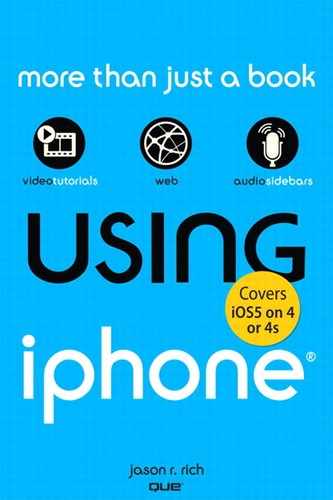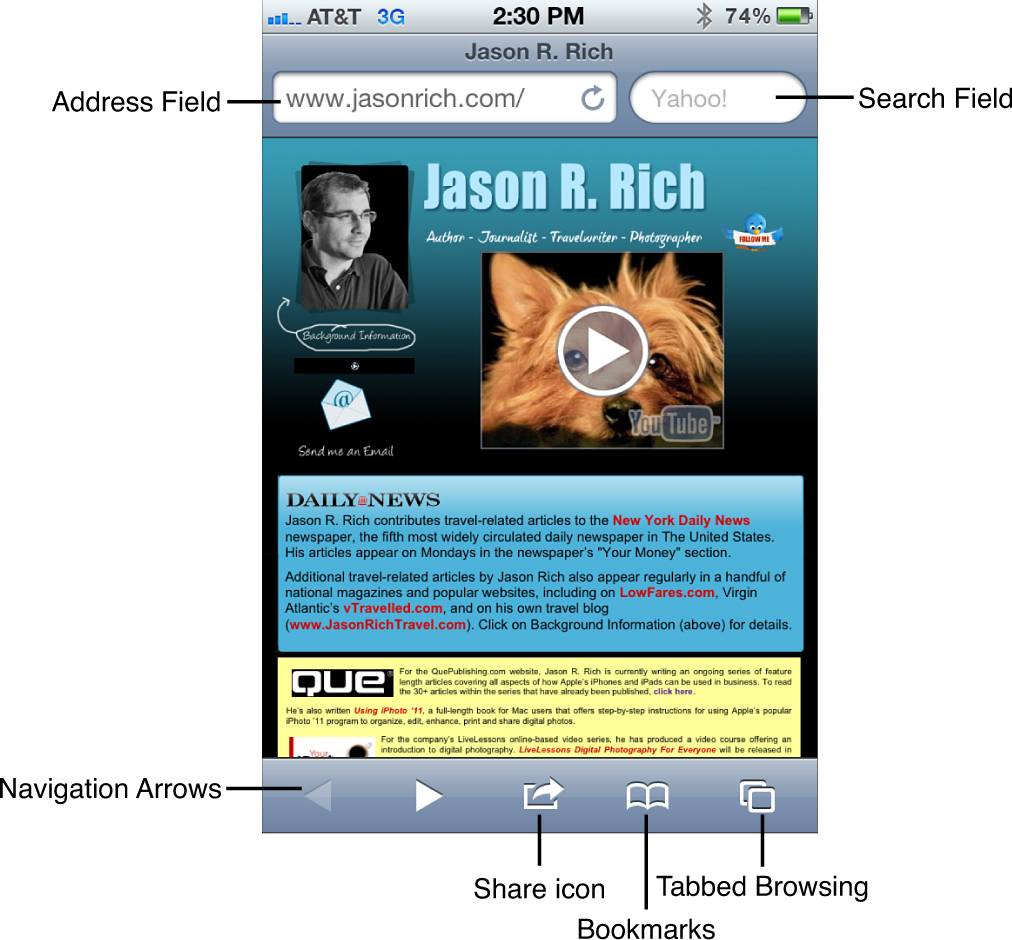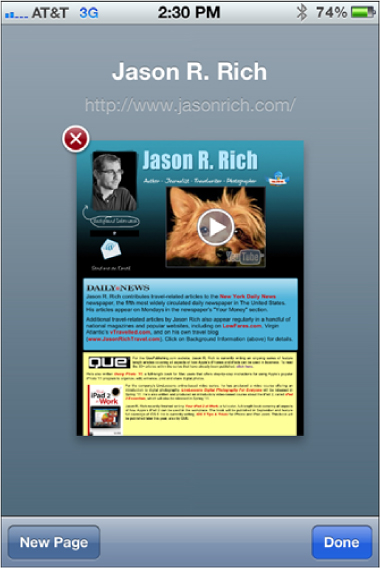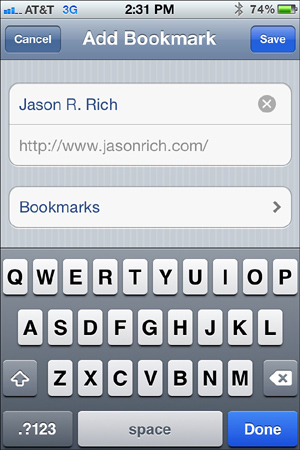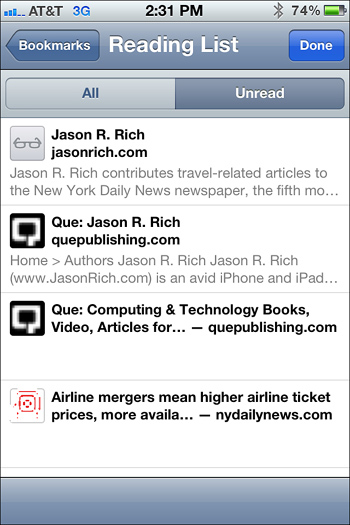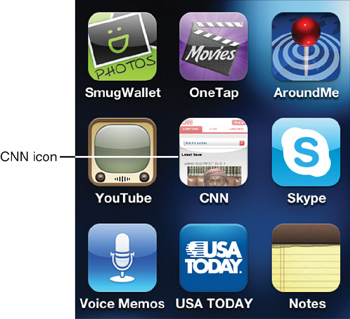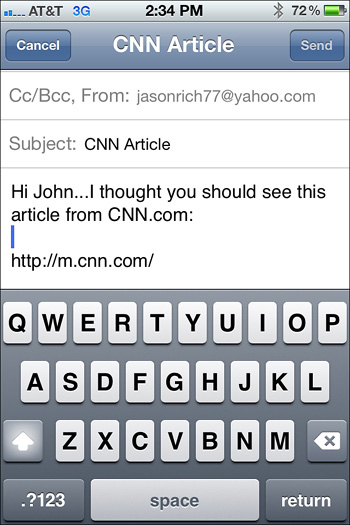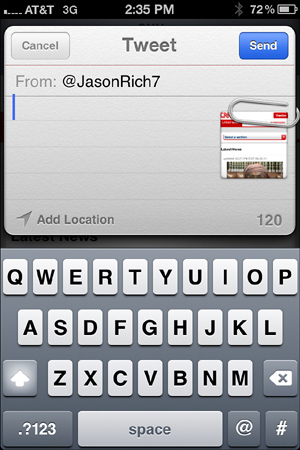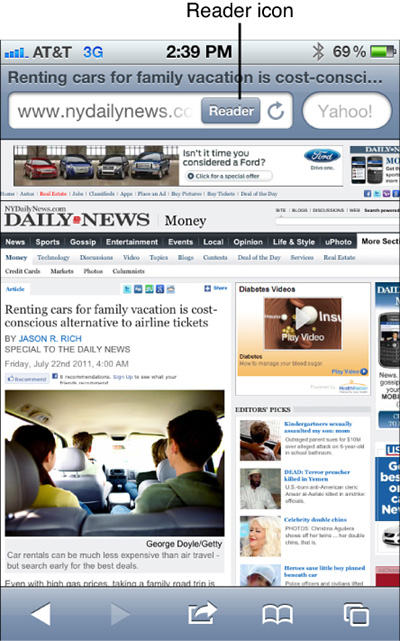Surfing the Web on Your iPhone
Anyone who has explored the Web knows that the answer to almost any question is always a few keystrokes away and that the Internet offers a vast information resource that is constantly growing and evolving. Thanks to the newly revamped Safari for iOS 5 web browser, accessing the Internet from an iPhone has never been a faster, more streamlined and enjoyable experience.
Using Safari, you can surf the Web using a 3G or Wi-Fi Internet connection, which means web access is available pretty much whenever and wherever you want or need it.
Thanks to its two antennas, you’ll discover a faster Web surfing experience using an iPhone 4S with its 3G capabilities, as opposed to using an iPhone 3Gs or iPhone 4 (which also have 3G connectivity, but only one antenna). However, the fastest Internet connection, with the fewest limits for any iPhone, is still available through a Wi-Fi connection.
What continues to be missing from Safari for iOS 5 is Adobe Flash compatibility, meaning that you cannot access Flash-based websites or view web pages that utilize Flash animations.
However, a fast-growing number of websites are moving away from Flash in favor of other programming tools that are fully compatible with iOS devices, including the iPhone.
If you want an iPhone web surfing experience that is compatible with many Flash websites, check out the Photon Flash Web Browser for iPhone ($3.99) from the App Store.
 TELL ME MORE Media 7.1—There’s No Flash Support in Safari
TELL ME MORE Media 7.1—There’s No Flash Support in Safari
Access this audio file through your registered Web edition at my.safaribooksonline.com/9780132954310/media.
Surfing the Web Using Safari for iOS 5
Safari for iOS 5 comes pre-installed on all iPhones and is a full-featured web browser designed to offer a robust web surfing experience that fully utilizes the iPhone’s screen-size and touch-screen capabilities.
After you launch Safari from the iPhone’s Home screen, the main browser screen (shown in Figure 7.1) offers a website address field near the top-left corner of the screen in which you can manually enter a website’s URL (address).
Figure 7.1 The main Safari web browser screen.
When manually entering a website URL into Safari’s website address field, you can use any of the following formats: http://www.website.com, www.website.com, or website.com.
To the right of the address field is a Search field. It gives you easy access to the Google, Yahoo!, or Bing Internet search engine. (You can choose Safari’s default search engine within the Settings app.)
Displayed at the bottom of the main Safari screen are a handful of command icons, including the Back and Forward arrow-shaped navigation icons used to jump to another web page, Share icon, Bookmarks icon, and Tabbed Browsing icon.
The center area of the screen is used to display the web page you’re currently accessing.
Switching Between Websites Using Tabbed Browsing
Tabbed browsing allows you to open multiple browser windows simultaneously and then quickly switch between them without having to re-enter each website’s URL or wait for each web page to reload.
 SHOW ME Media 7.2—Using Tabbed Browsing with Safari
SHOW ME Media 7.2—Using Tabbed Browsing with Safari
Access this audio file through your registered Web edition at my.safaribooksonline.com/9780132954310/media.
![]() LET ME TRY IT
LET ME TRY IT
Using Tabbed Browsing with Safari on an iPhone
To use tabbed browsing on an iPhone, follow these steps:
1. Launch the Safari web browser and surf to any website.
2. While you’re looking at that site within a browser window, tap the tabbed browsing icon, which is located in the lower-right corner of the Safari screen.
3. The browser window you were looking at remains open but shrinks (as shown in Figure 7.2). At the bottom-left corner of the Safari screen, a New Page icon appears. Tap it to open a second browser window.
Figure 7.2 With a flick of the finger, switch between up to eight open browser windows using Safari on your iPhone.
4. In Safari’s URL address field at the top of the screen, enter a website address, or tap the Bookmarks icon to access a website based on a saved bookmark. You can also use the Search field to enter a keyword or phrase to help you find exactly what you’re looking for on the Web.
5. The second website you just opened takes over the iPhone’s screen. However, if you tap the tabbed browsing icon again, you are able to swipe your finger from left to right and quickly switch between open browser windows. Once again, you have the option to tap the New Page icon to open a third browser window.
6. One at a time, you can open up to eight browser windows at once and quickly switch between them by swiping your finger from left to right, or from right to left.
7. Instead of switching between browser windows, after tapping the tabbed browser icon, tap the red-and-white “X” icon associated with one window to close it permanently.
Take Advantage of Safari’s Share Command Icon
The Share icon, which is located at the bottom-center of the Safari screen, offers a handful of menu options (shown in Figure 7.3).
Figure 7.3 Tap the Share icon to access any of the menu features listed.
Adding Bookmarks
Like all full-featured web browsers, Safari allows you to create bookmarks for web pages you visit frequently or that you’d like to revisit easily in the future. You can maintain a personalized Bookmarks list or update a Bookmark Bar (if you have your Bookmarks being synced with your computer or iPad’s web browser). Safari on an iPhone does not display a Bookmarks Bar. It treats this information like a separate Bookmarks list.
When you tap the Add Bookmark option, the Add Bookmark screen appears (shown in Figure 7.4). Here, you can enter the title for the Bookmark and its URL (Or use the information that Safari automatically plugs into these fields.)
Figure 7.4 You can add customized Bookmarks to your Bookmarks list and then return to those web pages later without having to remember or retype the website’s URL.
You also can decide whether the Bookmark should be added to your Bookmarks list or Bookmarks Bar. If you have multiple Bookmark folders within your Bookmarks list, you can place new Bookmarks in any of these folders.
If you have iCloud functionality on your iPhone turned on, you can automatically sync your Bookmarks with your computers and/or other iOS devices. You also can do this using iTunes Sync or Wireless iTunes Sync.
To do sync your Bookmarks using iCloud, turn on iCloud functionality from the Settings app. Launch the Settings app, and from the main Settings menu, tap the iCloud option. From the iCloud menu screen within Settings, turn the virtual on/off switch associated with the Bookmarks option to the on position.
The Bookmarks, Bookmarks Bar, and Reading List stored on your iPhone is now automatically synced with iCloud. When you also turn on this functionality on your computer(s) and/or other iOS devices, a synchronized listing of your Bookmarks list, Bookmarks Bar, and Reading List becomes available within each compatible web browser.
 SHOW ME Media 7.3—Using Bookmarks and the Bookmarks Bar
SHOW ME Media 7.3—Using Bookmarks and the Bookmarks Bar
Access this video file through your registered Web edition at my.safaribooksonline.com/9780132954310/media.
Using Safari’s New Reading List Feature
As you explore the Internet, you occasionally discover web pages and articles that you want to refer back to later. Instead of creating a separate Bookmark for the web page, you have the option to add any web page to your Reading List. To do this, tap the Share icon and then tap the Add To Reading List option.
When a web page is added to your Reading List, you can refer back to it at any time by tapping the Bookmarks icon within Safari (it looks like an open book) and selecting the Reading List option.
Your Reading List separates all web pages saved within it and categorizes each as either Read or Unread. When the Reading List window is displayed (shown in Figure 7.5), tap the All or Unread tabs to sort the saved web pages and articles.
Figure 7.5 Create a listing of saved web pages that contain articles or content you want to read or reread later. This is slightly different from creating a Bookmark for a website.
From the Reading List window, tap a listing to launch that web page and reread the article or view the website. Or while viewing the listings, swipe your finger from left to right across the listing to delete it. Tap the red-and-white Delete icon to confirm your deletion decision.
If you opt to synchronize your Safari-related bookmarks via iTunes Sync, Wireless iTunes Sync, or iCloud, you can also have your Reading List synchronize with your computer’s web browser and Safari that’s running on your other iOS devices.
Creating Web Page Shortcuts
If you visit certain web pages regularly, another alternative to storing them within your Bookmarks list is to create a Web Page Shortcut for them. When you do this, a Web Page Icon is displayed on your iPhone’s Home screen. Then, if you tap that icon, Safari launches and the web page the shortcut is linked to automatically opens.
As you’re surfing the Web, if you want to create a Web Page Shortcut for a web page you’re currently viewing, tap the Share icon. From the Share menu, tap the Add to Home Screen option. The icon that appears on your Home screen is a thumbnail of the web page’s main screen. However, you can enter the title for the Web Page Shortcut using the iPhone’s virtual keyboard. Keep the title to 13 or fewer characters.
When a Web Page Shortcut is displayed on your iPhone’s Home screen (shown in Figure 7.6), you can treat it like any other app icon or folder icon and move it around on the Home screen or add it to a folder, for example.
Figure 7.6 Web Page Shortcuts, like this one for CNN.com, can be displayed on your iPhone’s Home screen. They make it faster to launch frequently visited web pages.
![]() To learn more about customizing your iPhone’s Home screen, see “How to Create App Folders on the Home Screen,” (Chapter 3) or “Move Around Icons on the Home Screen,” (Chapter 5).
To learn more about customizing your iPhone’s Home screen, see “How to Create App Folders on the Home Screen,” (Chapter 3) or “Move Around Icons on the Home Screen,” (Chapter 5).
Mail Link to This Page
From any web page you visit within Safari, if you want to share that information with someone else, you can email one or more people a link to a web page within Safari.
To do this, tap the Share icon. From the Share menu, tap the Mail Link to This Page option. A New Message screen (shown in Figure 7.7) is displayed on your iPhone, allowing you to compose an outgoing email without leaving Safari. Notice that the website’s URL is already embedded within the body of the email message, and the Subject field has been filled in automatically.
Figure 7.7 You can compose and send an email message that contains a website link within Safari. You don’t even need to launch the Mail app.
To send an email, fill in the To field with one or more recipient email addresses. If you manage multiple email accounts on your iPhone, tap the From field to determine which email address the outgoing email message will be sent from. Then, if you want, change the Subject field and/or add text to the body of the outgoing email using the iPhone’s virtual keyboard.
After composing the message, tap the Send icon displayed near the upper-right corner of the screen. You then return to Safari and can continue your web browsing experience.
![]() To learn more about composing and sending emails, see “Sending and Receiving Email,” (Chapter 8).
To learn more about composing and sending emails, see “Sending and Receiving Email,” (Chapter 8).
Use the ‘Tweet’ Option to Send a Tweet from Within Safari
If you’re active on Twitter, as you’re perusing the Web, if you discover a website you want to share with your Twitter followers, compose and send a tweet within Safari.
To do this as you’re visiting a specific web page on your iPhone, tap the Share icon and select the Tweet menu option. A Compose Tweet screen appears (shown in Figure 7.8), and the URL for that web page is already attached to the outgoing message. Using the virtual keyboard, add whatever additional text you want to include in the tweet.
Figure 7.8 Within Safari, you can compose and send a tweet to your Twitter followers that has a website URL attached to the message.
If you’re managing multiple Twitter accounts from your iPhone, tap the From field to choose which account you want to send the tweet from. Then, if you want to include your exact location within the tweet, tap the Add Location option.
When you finish composing the tweet, tap the Send icon displayed in the upper-right corner of the screen. Your tweet is sent within Safari, and you are promptly returned to the main Safari web browsing screen.
![]() To learn more about using Twitter and the official Twitter app on your iPhone, see “Online Social Networking Sites from Your iPhone,” (Chapter 16).
To learn more about using Twitter and the official Twitter app on your iPhone, see “Online Social Networking Sites from Your iPhone,” (Chapter 16).
From Safari, You Can Wirelessly Print Content Using the Print Option
Thanks to the AirPrint feature built into iOS 5, you have the ability to wirelessly print web pages and related content from your iPhone. To do this, however, you need to have an AirPrint-compatible printer set up to work with your iPhone. HP offers a complete lineup of laser, inkjet, and photo printers that are AirPrint compatible, starting at under $100.
When looking at web content you want to print, tap the Share icon and then tap the Print menu option. From the Printer Options screen, select a compatible printer from the onscreen listing and select how many copies you want to create. Tap the Print icon, displayed at the bottom of the Printer Options screen, to send the web content wirelessly to the selected printer.
Exit Out of the Share Menu by Selecting the Cancel Option
Tap the Cancel option within the Share menu to exit this menu without using any of the menu options. You return to the main Safari web browsing screen.
Visiting Frequently Used Web Pages Using Safari Bookmarks
As you’re surfing the Web, you can create Bookmarks or add to your Reading List using commands offered by tapping the Share command icon. However, to access a saved Bookmark or to view online-based articles stored within your Reading List, tap the Bookmarks icon (which looks like an open book).
The Bookmarks icon is displayed between the Share and Tabbed Browsing icons at the bottom of the Safari screen (refer back to Figure 7.1). Tap it to reveal the main Bookmarks screen.
The Bookmarks screen offers separate options for your Reading List, Bookmarks Bar, Bookmarks menu, and History folder, just like it does on Safari running on a Mac. Tap whichever option you want.
If you have multiple folders stored within your Bookmarks menu (used to organize your saved Bookmarks), they also are displayed when you tap the Bookmarks icon. After accessing a Bookmarks folder, you can then launch whichever Bookmark you desire by tapping its listing.
To create a new folder to be displayed on the Bookmarks screen within Safari, from the main Safari screen, tap the Bookmarks icon. Then, from the Bookmarks screen, tap the Edit icon displayed in the lower-left corner. A New Folder icon then appears in the lower-right corner. Tap it and name your new folder from the Edit Folder screen. You also are able to determine where (in your folder hierarchy) the new folder will be stored and displayed.
To delete listings from your Bookmarks screen, tap the Edit icon displayed in the lower-left corner of the screen; then tap the red-and-white negative sign icon that corresponds to the listings you want to delete.
Keep in mind, if you have iCloud or iTunes Sync Bookmark synchronization turned on, these changes are reflected within the Bookmarks listing on all computers and devices with which iCloud or iTunes is set up to sync Bookmarks.
When you tap any Bookmark listing, the web page that is associated with that bookmark launches.
Keep Your Web Browsing Actions Private
Like most web browsers, Safari keeps track of every website you visit. This listing is automatically maintained within the History folder, which is also accessible by tapping the Bookmarks icon at the bottom of the Safari screen.
To clear your Safari History, from the main Safari screen, tap the Bookmarks icon and then tap the History Folder option. When the contents of your History folder are displayed, tap the Clear icon displayed in the lower-left corner of the screen. This can also be done within the Settings app. (See the “Customizing Your Safari Web Surfing Experience” section later in this chapter.)
Getting Rid of Onscreen Clutter with Reader
Many web pages are filled with ads, ancillary graphics, and other distractions. Likewise, an onscreen article you’re trying to read might be spread out across multiple web pages. Using the Reader feature built into Safari for iOS 5, you can eliminate all the onscreen clutter and view just the text and photos associated with a compatible online-based article.
Not all websites are compatible with the Reader feature. However, when this option is available, an icon that says Reader appears on the extreme right of the website address field, next to the website’s URL (shown in Figure 7.9).
Figure 7.9 When the Reader icon appears within the website address field of Safari (to the right of the website’s URL), you can use the Reader feature to eliminate onscreen clutter.
When you tap the Reader icon, the article you want to read opens in a new window, without all the onscreen clutter (shown in Figure 7.10).
Figure 7.10 When you open an online-based article using Reader (such as this one from the New York Daily News website), the Reader window eliminates all graphics, ads, and other clutter, allowing you to view just the text within an article and related photos more easily.
The official websites for many newspapers and news organizations, including CNN (www.cnn.com), the New York Daily News (www.nydailynews.com), and The New York Times (www.nytimes.com) are compatible with this feature.
![]() LET ME TRY IT
LET ME TRY IT
Using Safari’s Reader Feature to Eliminate Onscreen Clutter
To use Safari’s Reader feature when visiting a compatible website, follow these steps:
1. Visit the main home page for the website that supports the Reader feature, such as www.nydailynews.com, and then tap a specific article link. When the article opens, tap the Reader icon.
2. When a Reader window appears on your iPhone screen, in the upper-left corner of that window, tap the “a” icon to shrink the size of the onscreen text or tap the “A” icon to increase the size of the text.
3. As needed, you can now use your finger to scroll up or down on the uncluttered window displaying the article. Notice that the Reader icon displayed in the website address field turns purple when the feature is being used.
4. The commands available from the Share menu remain fully operational as you’re using Reader. This allows you to print, email or tweet the article, for example.
5. To close the Reader window, tap the Done icon displayed in the upper-right corner of the screen.
Safari’s Touch-Screen Controls
While viewing a web page, use your finger to scroll up, down, left, or right and navigate your way around. Double-tap any area of a web page (or use a reverse-pinch motion with your fingers) to zoom in on an area of a web page and then double-tap again (or use a pinch finger motion) to zoom out.
![]() To learn more about using finger gestures on the iPhone’s touch screen, see “Operating the Touch Screen,” (Chapter 3).
To learn more about using finger gestures on the iPhone’s touch screen, see “Operating the Touch Screen,” (Chapter 3).
Whenever you see a hyperlink within a web page, tap it to follow that link. If you see a photo on a website that you want to save within the Camera Roll Album of your iPhone’s Photos app, hold your finger on that photo until the Save Image and Copy command icons appear.
Tap the Save Image command to save the image on your iPhone or use the Copy command to temporarily store the image within the iPhone’s virtual clipboard so that you can paste it into another app.
You’ll discover that the iOS 5 Select, Select All, Copy, and Paste commands all work within Safari. Likewise, if you see a phone number displayed within a web-site, tap it. A pop-up window with a Call icon appears. When you tap Call, the Phone app launches, and a call to that number is initiated.
If you discover an email address displayed within a website that you want to send an email to, tap that email address. A New Message screen appears, and you can compose and send an email within Safari to that email address.
Meanwhile, if you see a Twitter address (@Username) within a web page, and you want to view that person’s or organization’s Twitter feed and profile, tap the @Username Twitter address, and Safari opens a new web page that displays the relevant Twitter account information.
To begin entering data into blank fields displayed on a web page (within an online form, for example), tap one blank field at a time. The iPhone’s virtual keyboard appears, and you can begin entering the requested data. To exit that field, tap anywhere else on the screen or tap the displayed Next icon (to jump to the next field of an online form). If there’s a Done icon, this too returns you to the main Safari screen and makes the virtual keyboard disappear.
When you’re filling in onscreen data fields on a web page, if you have Safari’s AutoFill option turned on, the web browser can automatically insert the appropriate information, such as your username or password for that website. You can turn on or off the AutoFill option within the Settings app.
Customizing Your Safari Web Surfing Experience
At any time, you can customize your Safari web surfing experience by adjusting the Safari app-related options using the iPhone’s Settings app.
![]() LET ME TRY IT
LET ME TRY IT
Using the Settings App to Customize the Safari App
To customize your web surfing experience using Safari on your iPhone, follow these steps:
1. Launch the Settings app from the Home screen.
2. From the main Settings menu, scroll down to the Safari option and tap it.
3. From the Safari menu screen within Settings (shown in Figure 7.11), you’ll find a handful of customizable options divided into the following categories: General, Privacy, and Security.
Figure 7.11 From the Safari menu screen within Settings, you can customize your web surfing experience.
4. Under the General heading, choose your default Search Engine for Safari. Tap the Search Engine option and then choose which will be Safari’s default Search Engine. Your options include Google, Yahoo!, and Bing.
5. You also can turn on or off the AutoFill option, which makes filling in repetitive fields of online forms less tedious, because your iOS device remembers past responses and automatically fills in the appropriate fields for things such as usernames and passwords.
6. The Open Links feature allows websites to open additional web pages on your behalf but keep them in the background until you’re ready to view them. The web page you’re currently viewing remains the active browser window.
7. Under the Privacy heading of the Safari menu screen, you can turn on or off the Private Browsing feature, which means that websites you visit do not appear within Safari’s History folder. You can also decide whether or not Safari will accept cookies from websites you visit. (A cookie is data that allows a website to remember who you are and any personalized settings or preferences you have related to a website.)
8. By tapping the Clear History icon, you can delete Safari’s History folder, which maintains a list of all websites you’ve visited. Tapping the Clear Cookies and Data field deletes any cookies stored on your iOS device related to specific websites.
9. The Fraud Warning, JavaScript, and Block Pop-Ups options all have a virtual on/off switch associated with them, and by default are in the on position. The Fraud Warning feature helps keep you from accidently surfing to fraudulent websites that pose as legit websites, and the JavaScript feature allows you to view websites programmed using JavaScript website design tools.
10. The Block Pop-Ups feature keeps websites from opening up random and unwanted pop-up windows as you’re surfing the web. If you’re not sure how to adjust any of these Safari-related options within the Settings app, leave the default options intact.
11. When you finish customizing Safari’s various options, press the Home button to save your changes and return to the Home screen.
